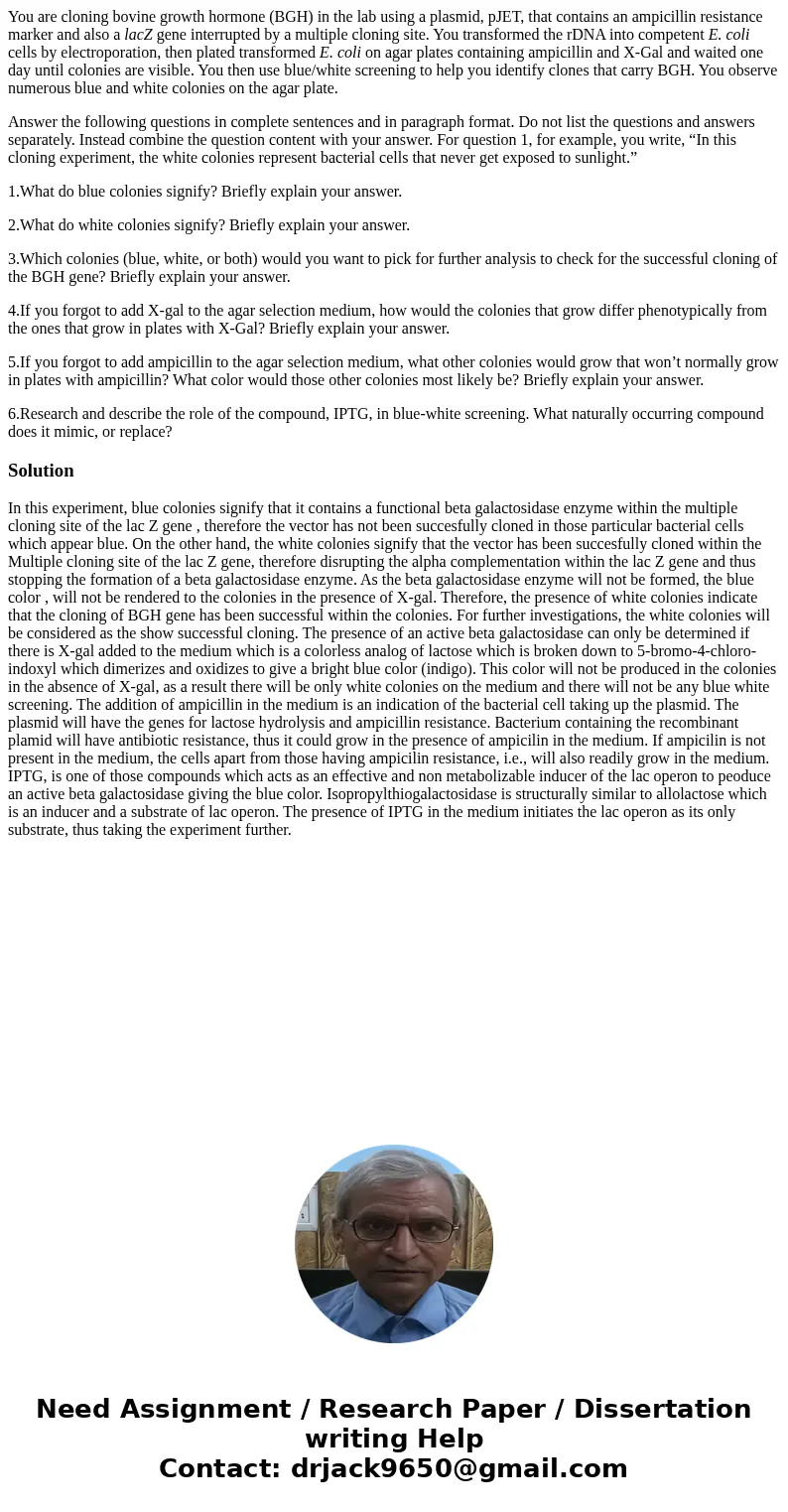You are cloning bovine growth hormone BGH in the lab using a
You are cloning bovine growth hormone (BGH) in the lab using a plasmid, pJET, that contains an ampicillin resistance marker and also a lacZ gene interrupted by a multiple cloning site. You transformed the rDNA into competent E. coli cells by electroporation, then plated transformed E. coli on agar plates containing ampicillin and X-Gal and waited one day until colonies are visible. You then use blue/white screening to help you identify clones that carry BGH. You observe numerous blue and white colonies on the agar plate.
Answer the following questions in complete sentences and in paragraph format. Do not list the questions and answers separately. Instead combine the question content with your answer. For question 1, for example, you write, “In this cloning experiment, the white colonies represent bacterial cells that never get exposed to sunlight.”
1.What do blue colonies signify? Briefly explain your answer.
2.What do white colonies signify? Briefly explain your answer.
3.Which colonies (blue, white, or both) would you want to pick for further analysis to check for the successful cloning of the BGH gene? Briefly explain your answer.
4.If you forgot to add X-gal to the agar selection medium, how would the colonies that grow differ phenotypically from the ones that grow in plates with X-Gal? Briefly explain your answer.
5.If you forgot to add ampicillin to the agar selection medium, what other colonies would grow that won’t normally grow in plates with ampicillin? What color would those other colonies most likely be? Briefly explain your answer.
6.Research and describe the role of the compound, IPTG, in blue-white screening. What naturally occurring compound does it mimic, or replace?
Solution
In this experiment, blue colonies signify that it contains a functional beta galactosidase enzyme within the multiple cloning site of the lac Z gene , therefore the vector has not been succesfully cloned in those particular bacterial cells which appear blue. On the other hand, the white colonies signify that the vector has been succesfully cloned within the Multiple cloning site of the lac Z gene, therefore disrupting the alpha complementation within the lac Z gene and thus stopping the formation of a beta galactosidase enzyme. As the beta galactosidase enzyme will not be formed, the blue color , will not be rendered to the colonies in the presence of X-gal. Therefore, the presence of white colonies indicate that the cloning of BGH gene has been successful within the colonies. For further investigations, the white colonies will be considered as the show successful cloning. The presence of an active beta galactosidase can only be determined if there is X-gal added to the medium which is a colorless analog of lactose which is broken down to 5-bromo-4-chloro-indoxyl which dimerizes and oxidizes to give a bright blue color (indigo). This color will not be produced in the colonies in the absence of X-gal, as a result there will be only white colonies on the medium and there will not be any blue white screening. The addition of ampicillin in the medium is an indication of the bacterial cell taking up the plasmid. The plasmid will have the genes for lactose hydrolysis and ampicillin resistance. Bacterium containing the recombinant plamid will have antibiotic resistance, thus it could grow in the presence of ampicilin in the medium. If ampicilin is not present in the medium, the cells apart from those having ampicilin resistance, i.e., will also readily grow in the medium.
IPTG, is one of those compounds which acts as an effective and non metabolizable inducer of the lac operon to peoduce an active beta galactosidase giving the blue color. Isopropylthiogalactosidase is structurally similar to allolactose which is an inducer and a substrate of lac operon. The presence of IPTG in the medium initiates the lac operon as its only substrate, thus taking the experiment further.

 Homework Sourse
Homework Sourse